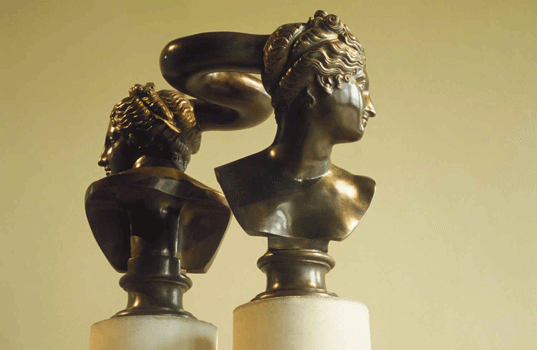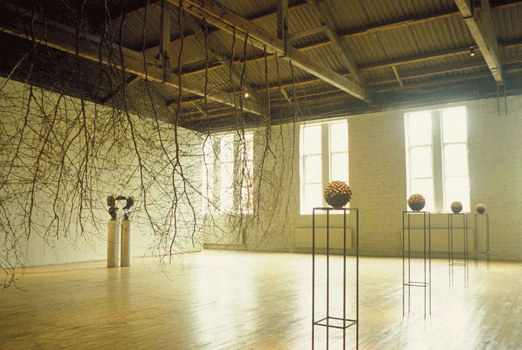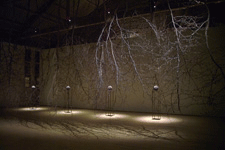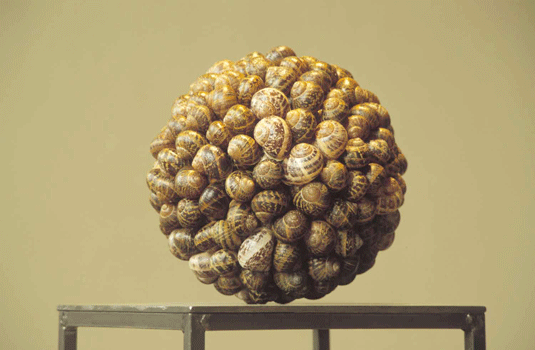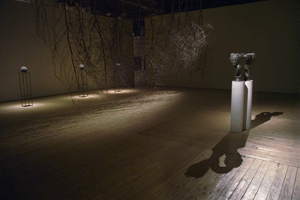John Noel Smith: United Field Painting: 2001-2005
John Noel Smith's sixth solo exhibition entitled United Field Paintings: 2001 - 2005 opens at Green on Red Gallery with a preview from 6 8 pm on Thursday 20 October. A catalogue with an essay by Medb Ruane accompanies the exhibition and appraises a fecund, five-year period in the artist's oeuvre. The United Field Paintings are works whose canvases Smith has divided into three distinct planes: a vivid colour-field area at the top of the canvas; a band of ogham-like marks in the middle, and a swathe of heavily impastoed black at the base from which vibrant colour bubbles up from underneath its surface.
Medb Ruane has written:
"The place of the eye is central to Smith¹s art of desire. Like Van Eyck or the wonderfully obsessive Hans Holbein, Smith tests the relations between being and seeing, inside and outside, open and closed."
There has been growing interest in the language of Smith¹s work following his return to Ireland after a lengthy residence in Germany. In the autumn issue of Irish Arts Review, Ciarán Bennett observed:
"The incorporation of Berlin practices and perceptions into the established ogham constructs is almost a final integration of the painter¹s self back into the landscape of place, now called home in Wexford.The influences of German art thought processes, particularly of Joseph Beuys, both distilling ancient symbolism for contemporary practices, is inherent to a sense of place and magic.It is the unabashedly rigorous involvement in the act of painting, the obsessive revisiting of motifs that defines Smith¹s work. The personal iconography of the work, ogham marks, knots and colour planes, the frequent use of diptych and triptych panels, reflect his interest in making seductive and striking work from a controlled distance."
The next exhibition at Green On Red Gallery is new paintings by Paul Doran (24 November 23 December, 2005). If you require any further information please contact Jerome O Drisceoil, Molly Sullivan, Karen Tierney or Jennifer Phelan
Alice Maher: Rood
Rood re-appraises Maher’s ten year exhibition history with the gallery and re-examines the gallery space itself. The result is a formidable large-scale installation incorporating such disparate elements as an upside down forest, four tiny globes, thousands of snail trails and a two-headed ‘garden’ sculpture.
The title of the exhibition refers to medieval rood screens, employed in early churches to separate the altar area from the congregation and often made of elaborately carved wood with foliage and animal motifs. The screen device is employed in a number of ways in this exhibition. Rood attempts to address the unnoticed and under utilised areas of the gallery - such as the roof space, the windows and the four openings at each corner of the main space.
Maher revisits specific practices and art works from the past ten years. A favourite sculpture from 1997 called The Hedge of Experience‚ (a tiny clipped formal hedge) has for this show metamorphosed into a monumental screen of trees which divides the space, forcing the audience apart and obscuring their usual perspective of the space and of each other. In each corner four snail covered globes invite our close engagement with the miniature, making tiny worlds out of the tiny universe of the snail and drawing us into dialogue about the interrelationships between the beautiful and the abject. Maher also references the placement of classical statuary in gardens by siting a double-headed Venus in the midst of Rood. The unearthly figure in this case however, appears more like a hydra, looking and wrenching in opposite directions. This Venus has its nascent roots in Maher’s ongoing interest in and interrogation of mythological themes. Finally, the artist subverts her more traditional drawing practice by employing the assistance of thousands of snails to create a complex tracery across the gallery windows, altering the light and changing the relationship of interior to exterior. The metamorphosis of the space, in part and as a whole, continues.
Fergus Feehily: The Overlap Areas
Green On Red Gallery is pleased to announce a show of new work by Fergus Feehily, which opens to the public on 18 March and runs until 16 April 2005.
Feehily has on several occasions quoted the singer Shirley Collins: "these ideas I have are like some of the songs-they have blurred edges...". This question of a blurring of edges is reflected not only in his overlapping and questioning of boundaries between drawing and painting but also in the complexities of looking; the disparity between the image and the construction of the image.
"I suppose I¹m quite interested in looking," Feehily comments, "and how we look, and hopefully some of the work can encourage that looking. Some of them are quite slow. One of the significant things about the paintings is that they often appear to be one thing and then show themselves to be something else. In a faint, or quiet painting, it can show itself to be quite loud. Or the ones that seem to have been made very quickly, as if the marks are perhaps arbitrary in some way, actually show themselves to be highly planned. The way in which it¹s made contradicts this idea. It looks like it could be a pencil drawing on the painting, but actually they are masked lines of paint."
Their sources and reasons for being are seemingly disparate and for Feehily they are. Works with semi-obscured letters sit alongside paintings which appear to be based on Venn-diagrams. Indeed, Venn-diagrams may offer a very simple opening to this work, in that they are about making connections, both in the individual works but also within the show itself. It could be said that Feehily makes works which refer to systems of various kinds, both organic and man-made, yet it is the surprising connections he makes or eludes to that show themselves to be at their heart most playful and anti-systematic.
Fergus Feehily completed his MFA in 2002 in Tokyo National University of Fine Arts and Music. Recent exhibitions include the solo show Tender Analysis (2004) in Yanagisawa Gallery, Tokyo, and group exhibitions Dublin Connection (2004), Galerie Michael Sturm, Stuttgart, and Colour Chart (2003) and Perspective (2004), Ormeau Baths Gallery, Belfast.
A Venn Notebook, a new book on Fergus Feehily¹s work designed by Ciarán O Gaora including an essay by David Toop, published by i.s + ZERO-G, will be launched on the opening night.
Fergus Feehily will be in conversation with Sarah Durcan in the gallery on Wednesday 23 March at 7 pm.
For further information please contact Jerome O Drisceoil, Georgina Jackson, Caoimhe Kilfeather or Jennifer Phelan at:
Group Exhibition: 2D
Paul Doran, Sarah Durcan, Patrick Hall, Mark Joyce, Conor Kelly, Jon Pylypchuk,
Royal Art Lodge, James Siena and Corban Walker.
Green On Red gallery is pleased to announce two d, a group exhibition opening Thursday 17 February and running until 12 March 12, 2005. Included in the exhibition are new paintings, drawings, mixed media and video work by Paul Doran, Sarah Durcan, Patrick Hall, Mark Joyce, Conor Kelly, Jon Pylypchuk, Royal Art Lodge, James Siena and Corban Walker.
This is the first time James Siena ( USA ) and Jon Pylypchuk ( CAN ) - previously of Royal Art Lodge - will show in Ireland. Sarah Durcan shows new paintings for the first time in the Green On Red Gallery. James Siena and Corban Walker both show in an important exhibition in Pace Wildenstein Gallery, New York, also this month, called Logical Conclusions : 40 Years of Rule-Based Art ( 18 February 26 March 26, 2005 ). See: www.pacewildenstein.com
All the work in this exhibition is joined not just by the miniature hand-rendered scale of a lot of the work but by a delicacy and intricacy in the manufacture that makes a strong contrast to the recent run of installation/video works shown in the gallery's Œ04/05 programme.
"When I make a painting I respond to a set of parameters, like a visual algorithm. These structuring devices are subject to the fallibility of my hand, and my mind¹s ability to complete the work as planned. " [ Siena ] likens his work to that of a software programmer or, more precisely, a human computer executing a string of programs.
In Whitney Biennnial 2004, Whitney Museum of American Art, New York, 2004, p 234
In two d the viewer is drawn in close. Their eye is put to work in a different way to decode the systems or method used in the drawing, collage, painting or video work on view. We are not concerned so much with the active and overt role of the viewing audience. This show is not about how that viewer occupies theatrically the gallery space or how they negotiate or trigger a reaction in that space. The dynamic in two d is more to do with the intimate encounter of an artwork; the one to one engagement with an object that shuts out the surrounding space. The jewel-like complexity of Walker¹s cad drawings, the dark emphatic wit of Royal Art Lodge and Pylypchuk's collages and the optical wizardry of Kelly's closely observed moments at Brighton Pier, bordering on trompe l'oeil, all conspire to pull us right up close. These are worlds of intense imaginings and formal discoveries that pulsate with energy.
For further information please do not hesitate to contact Jerome, Georgina, Caoimhe or Jennifer at the Green On Red Gallery, t. + 353.1.6713414 or e. info@greenonredgallery.com
Group Exhibition: Press Play
Press Play
Conor Kelly, Tim Lloyd, Maria Marshall, Jonathan Monk, Silke Schatz, Julianne Swartz Curated by Georgina Jackson
Green On Red Gallery is pleased to present PRESS PLAY. This is the sixth in a series of curated group exhibitions at the gallery and examines the practice of six artists: Conor Kelly, Tim Lloyd, Maria Marshall, Jonathan Monk, Silke Schatz and Julianne Swartz.
PRESS PLAY references as a starting point, the moment before the action, the questioning of time, perception and positioning, and the moment before we press play. It asserts an engagement with the action and movement of time and space and an affirmation of perception and cognition as temporal processes dependent upon a dynamic amalgamation of past and present. The moment is one of reflection, excitement, anticipation, hesitation and anxiety, part of our everyday reality and perpetual present.
Conor Kelly (lives and works in London) although primarily known for his use of sound, has increasingly involved film and video in his work. In which the familiar becomes infused with sounds to create a soundtrack of viewing. The orchestration of the unobserved delights of our daily surroundings, lights flashing, rain falling and leaves swaying, plays internal rhythms, pulsating sounds and the fantastical.
Tim Lloyd (born 1968, lives and works in Dublin) places at the forefront of his practice physical investigation and experiments. His exploration manifests itself in a performance-based engagement that is playful and inventive, choreographing activities and actions for the purpose of documenting them to video. For this exhibition Lloyd worked in situ to produce a video installation that responds to a storage space within the gallery.
Maria Marshall's (born 1966, lives and works in London) video projections revive the psychological dimension of the cinema, employing visual charm to seduce the viewer. Their hypnotic looping underlines the violence inferred and produces a sense of uneasiness. Marshall combines fantasy and fairytale, dreams and reality, childhood and adulthood to question our real anxieties and traumas.
Jonathan Monk (born 1969, lives and works in Berlin) replays Conceptualism's high concerns while at the same time offering witty and thoughtful abuses, proposing a sensibility rooted in the how we look at things now. Monk bridges the gap between high art and the apparently insignificant moments of our life, with irony, humour and wit.
Silke Schatz (born 1967, lives and works in Cologne) questions the principle of memory and examines our perceptual link to places and time, often referencing moments of cultural interstices. Her fine line renderings of perceived and lived in spaces make transparent a multitude of adjoining spaces. The subjective transparency of the drawings on one hand stands in direct opposition to their accurate representation on the other. A paradox that is inherent to memorisation.
Julianne Swartz (born 1967, lives and works in New York) works primarily in sculptural installations that explore the materiality of light, and question transmission and perception. Swartz employs motion, light, reflections, sound and understated materials to transform everyday spaces into something extraordinary and unexpected. As she states, "where the wondrous and mundane can occur simultaneously".
Special thanks to the artists, Galerie Arndt & Partner (Berlin), Fordham Gallery (London), Josée Bienvenu Gallery (New York), Galerie Meyer Riegger (Karlsruhe), Peer (London) and Galerie Yvon Lambert (Paris)
